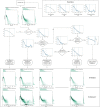A theory-based model of cumulative activity
- PMID: 36115875
- PMCID: PMC9482623
- DOI: 10.1038/s41598-022-18982-3
A theory-based model of cumulative activity
Abstract
Energy expenditure can be used to examine the health of individuals and the impact of environmental factors on physical activity. One of the more common ways to quantify energy expenditure is to process accelerometer data into some unit of measurement for this expenditure, such as Actigraph activity counts, and bin those measures into physical activity levels. However, accepted thresholds can vary between demographics, and some units of energy measurements do not currently have agreed upon thresholds. We present an approach which computes unique thresholds for each individual, using piecewise exponential functions to model the characteristics of their overall physical activity patterns corresponding to well established sedentary, light, moderate and vigorous activity levels from the literature. Models are fit using existing piecewise fitting techniques and software. Most participants' activity intensity profile is exceptionally well modeled as piecewise exponential decay. Using this model, we find emergent groupings of participant behavior and categorize individuals into non-vigorous, consistent, moderately active, or extremely active activity intensity profiles. In the supplemental materials, we demonstrate that the parameters of the model correlate with demographics of age, household size, and level of education, inform behavior change under COVID lockdown, and are reasonably robust to signal frequency.
© 2022. The Author(s).
Conflict of interest statement
The authors declare no competing interests.
Figures




References
-
- World Health Organization. Healthy Diet, (accessed 22 September 2021). https://www.who.int/publications/m/item/healthy-diet-factsheet394 (2018).
-
- World Health Organization. WHO guidelines on Physical Activity and Sedentary Behaviour, (accessed 22 September 2021); https://www.who.int/publications/i/item/9789240015128 (2020). - PubMed
Publication types
MeSH terms
Grants and funding
LinkOut - more resources
Full Text Sources
Medical

